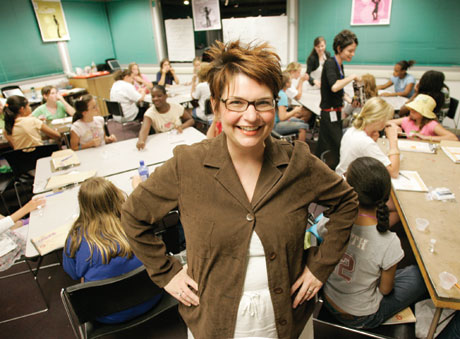Back

Our perceptions of scientists, even at the youngest of
ages, usually include white lab coats, pocket protectors,
crazy hair—and men. Try it yourself; ask your child
to draw a scientist.
At the Girls, Math & Science Partnership, we’re
focused on changing these perceptions—dramatically.
Our mission is to engage, educate, and embrace girls as
architects of change. By focusing on girls 11–17,
a demographic that often falls in love with science and
then out of love with it somewhere in middle school, our
goal is to build a network of girls that just might change
the world with math and science.
Why does it matter?
Embracing girls in the fields of math and science makes
sense for two key reasons—one intellectual, the other
economic.
Taking neurology into account, women’s minds are
built differently than men’s—no real surprise
to any of us, of course! Women, for instance, have a larger
speech area and also have stronger connections between
their left and right brain—making them more holistic
thinkers. Men, on the other hand, have enhanced capacities
with their spatial abilities. This means that, when a woman’s
intellect is brought to bear in the science arena, she
thinks in a different way than if “the lab” was
full of men. Diverse thinking leads to better discoveries—and
more innovative ones. New questions are also emerging about
what role women’s emotional intelligence may play
when it comes to math and science.
Now consider the larger picture. In southwestern Pennsylvania,
by the end of this decade, 2.2 million jobs in science
and technology need to be filled. But only 9% of women
(compared to 26% of men) are pursuing degrees in these
fields. Ironically, our regional economic revitalization
is built on science and technology.
What’s happening here mirrors the situation nationally.
Consequently, America is losing valuable ground to those
countries that invest more systematically in building a
science and technology workforce—especially among
its female population.
Our visions are becoming more focused: To maintain global
economic vibrancy, our government is currently undertaking
a major initiative through U.S. Secretary Spellings’ Department
of Education that will bring more professional role models
into our classrooms. Secretary Spellings spoke in May at
the first-ever National Summit on the Advancement of Girls
in Math and Science, saying, “We're reaching out
to bring professionals from the field into our classrooms...who
better than [scientistst like] Sally Ride to show students
what math and science can accomplish in the real world?
Our country can't afford to lose half of our potential
innovators, especially in this ever-flattening, iPod-loving,
Tivo-watching world.”
What we’re doing
The Girls, Math & Science Partnership has a number
of fun, creative programs aimed at moving the needle and
improving the odds of girls pursuing math or science as
a career.
BrainCake.org is an online sisterhood launched in March
of 2005, and in only its first year it had more than two
million hits. The site is built to encourage girls to express
their opinions openly, learn about programs that build
their knowledge, and build a supportive intergenerational
network of females (mentors and kids alike) focused on
science.
Girls on BrainCake.org don’t hesitate to talk openly
about “being the only girl” in science and
math. They are already aware, at this age, that they are
a rarity. Many express a deeply resolute love of science.
But many say they aren’t so sure about the subject.
In a recent poll, when asked about what kind of career
they might choose—a chemist studying makeup? a mathematician
solving environmental issues?—more than a quarter
of the girls say “I’m not sure math and science
are for me.” So, this online environment appears
to have a broad appeal to girls of all capacities in science.
Click! was launched this summer. The only mixed-reality
summer camp in the nation (part “Real World,” part “Charlie’s
Angels”), Click! is geared to 11 – 14 year-old
girls. Girls attending the first camp in Pittsburgh solved
a biomedical mystery by taking on different roles and engaging
in science activities, technology, and team-building. The
camp culminated in the girls proposing their own solution
to the mystery by searching the North Shore for clues,
interviewing witnesses, and using digital cameras and cutting-edge
technology including global positioning systems and a computer
operating system designed only for Click! “agents.”
BrainCake and Click! are just at their earliest stages,
and we have several more programs currently under development.
But we’re hopeful that—one program, one girl
at a time—we can help more girls see themselves in
those science lab coats, and see themselves in a position
to change the world through math and science.
About GMSP: Born out of The Heinz
Endowments 1998 study, Promising Futures, the Girls, Math & Science
Partnership was created to address issues regarding girls,
their participation
in science, and the expansion of their influence on the
regional workforce. In 1999, The Heinz Endowments began
collaborating with the Alcoa Foundation and Family Communications,
Inc., to incubate the partnership, establishing its commitment
to scientific literacy projects that have long-term impact
and ensure that women play a vital role in the region’s
future. Carnegie Science Center is now providing the administrative
oversight for the partnership and acting as a steward of
its continuing mission.
For more information, contact Jennifer
Stancil at stancilj@carnegiesciencecenter.org. Back
| Top |